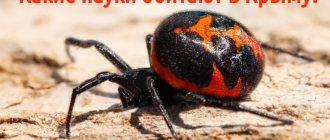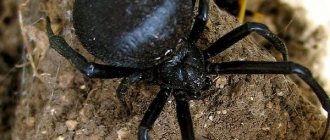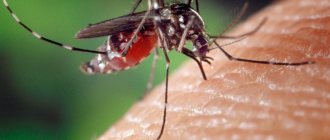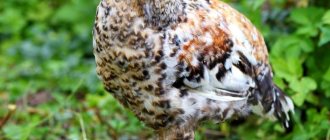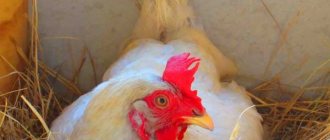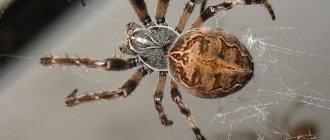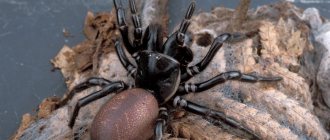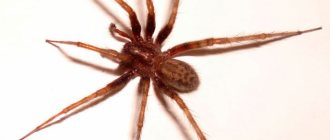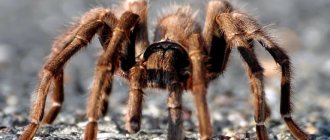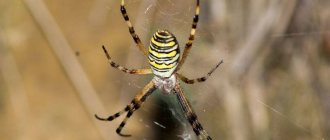Spiders in Latin are Araneae, Aranei. They belong to the animal kingdom, the phylum of arthropods, the class of arachnids. There are 42 thousand modern species of spiders in the world, about 1.1 thousand fossils. They are widespread, inhabiting almost all continents of the globe. Obligate carnivores - feed on insects, small animals, and amphibians. An exception is the jumping spider Bagheera kiplingi, whose diet consists of the green part of the acacia tree. On the territory of Russia and the former CIS countries there are 2888 species. The science of spiders is called arachnology.
Comparison
Today there are about 42 thousand species of spiders on Earth. They are distributed everywhere. Apart from the jumping spider, all other animals of this order feed on other animals - insects, other spiders or small animals.
Insects are ubiquitous. To date, more than a million species have already been discovered, described and studied.
The spider's body consists of two sections - the cephalothorax and abdomen. Both parts are connected by a thin, short stem. On the cephalothorax there is a groove separating the head and chest parts. It is from the spider’s cephalothorax that the chelicerae “grow”—the spider’s two- or three-membered oral appendages with ducts of poisonous glands—and the entire “magnificent eight” of seven-membered legs. In the cephalothorax there are nerve nodes that form the central nervous system, brain and sensory organs, represented by simple eyes. Sensory hairs that detect odors and sound waves are located on the segments of the legs.
The body of insects consists of three sections - head, thorax and abdomen. On the head they have complex-faceted or simple eyes, antennae and mouthparts - sucking, gnawing, licking or piercing. The six segmented legs of insects are attached to the thoracic region of the body. In some subclasses of insects, a pair of wings also “grows” from the chest.
In the abdomen of the spider there is a heart that drives hemolymph, “book lungs”, a digestive gland, Malpighian glands, gonads and a spinning apparatus. Thanks to the glands located in it, the spider produces a web. Half of its chemical composition is the protein fibrin.
In the abdomen of the insect there are Malpighian vessels, genital organs with a diverse set of copulatory apparatus, which in some orders sometimes plays the role of a sting.
External structure of an insect using the example of a bee
Spiders catch their food using a web and inject poison (digestive juice) into it. After waiting several hours for the poison to dissolve the internal contents of the victim, the spider sucks out this nutrient solution using a sucking-type mouth opening located at the top of the tubercle between the chelicerae.
Insects are omnivores, they eat plants, animals, devour corpses, and are characterized by cannibalism.
Female spiders are in most cases larger and more colorful than males. Often, after mating, spiders eat their males. The color of all types of spiders uses only two color pigments - bilin and guanine.
In insects, sexual dimorphism and sexual polymorphism are noted - two types of females in bees, three types of males in stag beetles. The life cycle of insects is characterized by metamorphism, in which the animal goes through the stages of larva, pupa and adult. Insects can jump, fly, swim, live underwater, and glow in the dark. They are able to communicate using sounds and have the ability to excellently navigate in space.
What kingdom do spiders belong to?
Small creatures, which are often found in the wild, in your own home, apartment, attics, outbuildings, resemble all kinds of insects and beetles. Spiders and insects are often combined into one family due to their small size and similar lifestyle. However, in tropical countries. where arthropods up to 35 cm in size live, such associations practically do not arise.
There are 5 kingdoms in total - animals, plants, fungi, bacteria and viruses. Historically, spiders and insects belong to the same kingdom, phylum - animals, arthropods. Only the class or squad is different. Therefore, the question of whether a spider is an animal or an insect is fundamentally wrong. The animal is a kingdom, insects are a class.
On a note!
Since everyone has long been accustomed to the fact that insects are insects, and animals are full-fledged mammals, confusion in concepts has arisen among ordinary people. Why the spider stands apart is explained by its unusual lifestyle and small size. In order not to seem uneducated, you need to clearly understand that a spider is not an insect.
Spiders
Conclusions TheDifference.ru
- The number of insect species exceeds the number of spider species.
- Spiders have 8 legs, insects have 6.
- The body of spiders consists of two sections, while that of insects has three.
- Only spiders are capable of producing webs.
- Spiders produce venom that is intended for external digestion.
- The life cycle of insects involves transformations - metamorphism; spiders do not have this phenomenon.
- The nervous system, behavior and communication of insects are much more complex than those of spiders.
Species and orders
It is very simple to answer the question of which order spiders belong to. To the order with the same name - spiders. They stand apart. They differ from other animals in their lifestyle, size, reproduction, and nutrition. There are differences among themselves in the same family, depending on what species the spiders belong to.
Spiders
General characteristics:
- The body consists of 2 parts - the cephalothorax, the abdomen is oval, round in shape.
- There are only 4 pairs of legs, a pair of chelicerae, and pelipalps.
- There are no antennae, but the forelimbs can be claw-shaped and end in claws.
- What distinguishes arachnids from insects is their ability to form webs. Not everyone weaves trapping nets, but they use threads of their own production to form a cocoon, move down, and migrate over long distances.
- Predators have poisonous glands that paralyze the prey. They turn the insides into a liquid mass.
- Unlike insects, they rarely live in pairs or in large families. All spiders lead a solitary lifestyle. In some species, young spiders live with their mother until they get stronger. Almost all females eat males after fertilization or in the near future.
Arachnids live everywhere, some of them get into a person’s house, apartment, or settle in utility rooms. Exotic, most beautiful specimens are kept as pets.
How does a spider weave a web?
The thread of the web consists of many thin threads, which the spider glues together with a special liquid that quickly hardens in air. Thanks to this, the strength of the web is achieved so high that spiders even travel with its help, covering kilometers of distance.
The web can be dry, sticky, elastic - it all depends on the purpose of the thread.
Types of threads for webs:
- for cocoon
- catching sticky thread
- for moving
- to entangle prey
- thread for fastening
The design of the web depends on the hunting method. When weaving, spiders use a thread that reflects ultraviolet rays, which most insects see. Moreover, the spider weaves ultraviolet-reflecting threads in such a way that they look like flowers, which also reflect ultraviolet. Therefore, insects fly to an alluring and sweet flower and end up in a web.
Stages of weaving a web:
- The spider releases a long thread first. Such a thread is picked up by the air flow, rushes to the nearest branch and clings to it (Fig. 1, 2).
- Then another free-hanging thread parallel to the previous one is woven. The spider moves to the middle of this thread, which is stretched under its weight, and weaves another thread in a downward direction until it finds a third support (Fig. 3).
- The spider attaches a thread to the support and forms a Y-shaped frame.
- Next comes the general contour and several more radii (Fig. 4).
- An auxiliary spiral is woven at these radii (Fig. 5). This entire frame is woven from non-sticky thread.
- Next, the spider weaves a second spiral with a sticky thread, towards the middle of the web from its edge.
Construction may take 1-2 hours.
Class "arachnids"
The fact that spiders are defined in a separate class "arachnids" should not raise any questions. All animals of this class have a characteristic feature - their body is divided into 2 parts: the abdomen and the cephalothorax.
There is another difference that immediately catches your eye - the presence of 8 legs, instead of 6. Arachnids also have chelicerae, which are located in front of the cephalothorax, as well as pelipalps, similar to tentacles. As a rule, they are located on the sides, differ in size from the front legs, but perform the same functions: with their help the spider holds its prey and moves.
It is important to know! Spiders belong to the class “arachnids” and are a species of arthropods.
Cricket
Modern city residents mostly know about crickets from the fairy tale “Pinocchio” and often don’t even imagine the appearance of the insect. An ordinary cricket looks scary. It can reach gigantic size. It is believed that a cricket in a home means good luck and prosperity. However, all the people who have this insect settled in are trying to get rid of it.
There are 2.3 thousand species of crickets, but only 50 live on the territory of the Russian Federation. Field cricket and house cricket are common in Russia. In the south of our country, the house cricket lives in houses and in nature. In the central and northern parts of Russia, the cricket lives only in houses near people, preferring warm rooms with high humidity. Crickets often live and breed in damp, warm basements. They often spoil things and products.
Book louse
The book louse is a tiny parasite that causes irreparable damage to book depositories, herbariums, grain stocks and other dry products. To feed, the parasite requires organic remains of plant and animal origin. In the home, the insect lives among dusty things and book bindings. It often damages the spines of books containing glue. A cluster of book lice is indicated by a faint ticking sound. It cannot be confused with anything. These insects do not affect human health, but their presence is detrimental to rare books and archival documents. Cleanliness and dry air are the main preventive measures.
Man and Spider
Spiders play a fairly significant role in people's lives:
- arthropods destroy many insect pests, thereby helping to preserve the yield of agricultural plants;
- in some countries, properly cooked spiders of certain types are considered a delicacy;
- scientists are actively studying the properties of spider venom and exploring the possibilities of its use in medicine to treat various diseases, for example, Alzheimer's disease or erectile dysfunction;
- some varieties are very popular as exotic pets;
- physicists are studying the unique properties of the web and its role in the life of spiders and are trying to create a similar material.
In addition, the unusual appearance and abilities of arthropods have become the reason that spiders often become characters in works of art - comics, books, films.
But the danger of spiders to people is quite exaggerated. Indeed, the bite of some poisonous individuals can cause health problems, but most often the person provokes the attack himself. Cases of spiders attacking people for no reason are extremely rare.
Arachnophobia
Arachnophobia or fear of spiders is one of the most common and difficult to treat phobias in the world. People suffering from this pathology experience attacks of fear and sometimes panic at the sight of even the smallest and most harmless spider.
Arachnophobia
Moreover, not only a living individual, but also its image can cause negative emotions. Attacks are often accompanied by weakness, dizziness, nausea, and increased sweating. Particularly sensitive people faint.
An interesting fact is that most patients have never experienced an arachnid attack, so their fear is unfounded.
